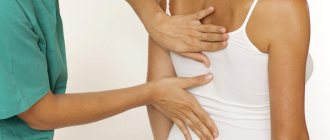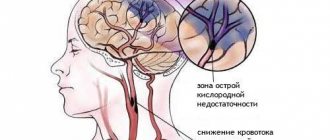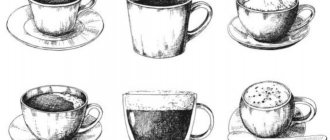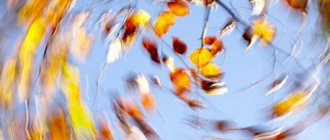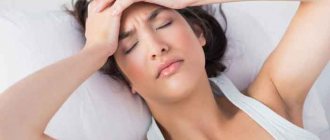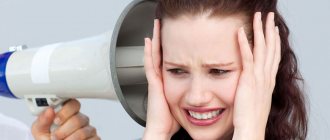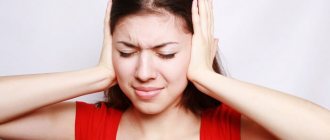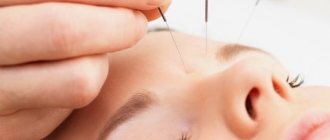Headache and dizziness are among the most common symptoms encountered by doctors. There are many reasons for these manifestations, but mostly they indicate a disorder in the balance system or disorders in the brain. Since the brain depends on oxygen supply and a proper internal environment, it can be affected by cardiovascular diseases and imbalances in any part of the body.
What could it be?
Why might this symptom appear? Trying to determine on your own the cause of dizziness and back pain is unrealistic, since there are a huge number of reasons. Here are the most common:
- damage to the vertebrae and adjacent tissues;
- local hypothermia due to drafts or unseasonable clothing;
- awkward, sudden movement of the neck;
- increased intraocular pressure;
- acute seasonal infections - respiratory, influenza;
- chronic inflammatory diseases of internal organs (stomach, heart, kidneys), ENT organs (ear, throat, nose) or dental;
- stroke starting with decreased vision;
- genetic predisposition in the form of underdevelopment of connective tissue;
- poor posture;
- occupational hazards – toxic emissions, fumes, noise, vibration, high air temperature;
- drug overdose;
- stress and neuroses;
- sedentary lifestyle in obese people;
- prolonged static (from immobility) tension in the muscles of the back, shoulder and neck.
There are many causes of dizziness and back pain
By analyzing the factors that cause back pain and dizziness, some differences can be found in men and women.
Diagnostics
Negative manifestations of aches and pains are formed due to various factors. Differential examinations are considered an excellent form to detect the real disease from others that have similar symptoms.
READ MORE: Chestnuts for joints: recipes for tinctures for the treatment of rheumatoid arthritis, use and contraindications
If the usual tests do not reveal the presence of pathologies (infectious, inflammatory, etc.), then the diagnosis is “fibromyalgia”. Frequent shocks, prolonged overwork, sleep disturbances, and depression are symptoms of such a disease.
To cure aches localized in various areas of the body, it is important to initially identify the main cause and eliminate the detected factor that provoked such manifestations.
It is necessary to carry out additional procedures in combination with basic therapeutic measures. They will help relieve symptoms and improve the condition of the body as a whole.
Can be used:
- reflexology using acupuncture needles;
- massage manipulations;
- hypnotic actions;
- do yoga, meditate.
Along with such sessions, medications are used (antidepressants, anti-inflammatory, steroid-free, hormonal). In any case, before use, you should consult your doctor.
Author of the article: Neurologist of the highest category Tatyana Mikhailovna Shenyuk.
Causes for women and men
Women more often suffer from hormonal disorders that accompany the menstrual cycle, pregnancy and childbearing. Many women are bothered by weakness and lightheadedness during premenstrual syndrome. Women react violently to stress, and family troubles are especially traumatic for them.
Pregnancy can be accompanied by toxicosis, which causes dizziness and pain throughout the body. Hormonal changes during menopause can also cause back pain and dizziness.
In men, such disorders are more often caused by ignoring arterial hypertension and high physical activity. Arterial hypertension develops unnoticed, and treatment is always delayed.
Increased physical activity leads to premature wear of the intervertebral discs. If osteochondrosis begins in the cervical spine, then a large hernia or osteophyte can disrupt the blood supply to the vertebral arteries, causing the posterior parts of the brain to suffer. This is where the higher cortical centers of the vestibular apparatus are located, which causes dizziness.
Internal illnesses can cause discomfort. We'll talk about them below.
Diseases of internal organs
Since the nervous system permeates the entire body, pain in the back and loss of coordination in the form of non-systemic dizziness can occur with various diseases of the internal organs.
Infections
A large group of diseases affecting internal organs:
- osteomyelitis;
- tuberculosis;
- sarcoidosis;
- shingles.
Osteomyelitis is an inflammation of the bone marrow that affects all parts of the bone. Occurs after injuries and operations, fractures, gunshot wounds or due to chronic infection. Clinical and radiological diagnostics. Treatment is inpatient, treated by trauma surgeons, the main method is surgical sanitation. If necessary, puncture the joints with the introduction of antibiotics into the cavity. At the same time, infusion therapy is carried out - transfusion of blood plasma, albumin, and in severe cases, hemosorption.
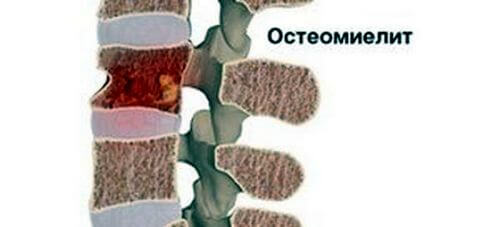
What is osteomyelitis
Tuberculosis affects any organ, especially the lungs. Progression is manifested by hemoptysis, persistent cough, weight loss, and weakness. X-ray and laboratory diagnostics. Sputum microscopy is of particular importance. First-line drugs - Isoniazid, Rifampicin, Ethambutol, Pyrazinamide. The treatment is carried out by a phthisiatrician.
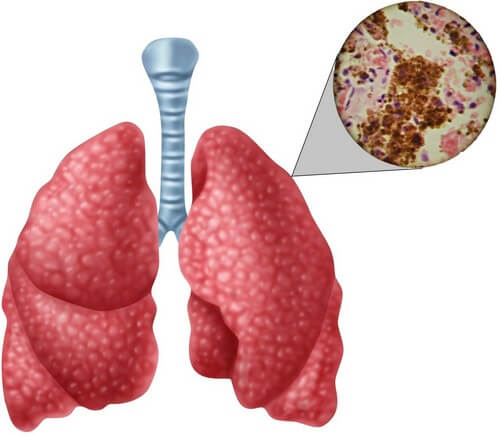
What is tuberculosis
Sarcoidosis is a benign systemic granulomatosis (focal growths of connective tissue are formed), most often affecting the lungs. It is asymptomatic for a long time. The lung tissue is replaced by connective tissue, and respiratory failure develops. In the later stages, cough, shortness of breath, chest and back pain are bothersome. Diagnostics – radiography, CT, MRI, laboratory tests. Treatment - steroid hormones (Prednisolone), anti-inflammatory drugs (Indomethacin, Aspirin), immunosuppressants (Azathioprine), antioxidants (Retinol). Pulmonary sarcoidosis is treated by a pulmonologist.
Herpes zoster is a herpetic infection that affects nerve fibers, trunks and skin. Treated by a neurologist or dermatologist. It manifests itself as a blistering rash along the peripheral nerve, accompanied by severe pain. Clinical and laboratory diagnostics - determination of the concentration of immunoglobulins of different classes. Treatment – antiviral agents (Acyclovir, Zovirax, Virolex), local skin treatment, physiotherapy.
Vascular diseases
Back pain and dizziness can be caused by an aneurysm (saccular dilatation) of the abdominal aorta and an epidural hematoma (an accumulation of blood between the bones of the skull and the dura mater).
An abdominal aortic aneurysm is a dissection of the aortic wall that results in the formation of a false canal. Occurs in the elderly, pregnant women over 40 years of age, after injuries, with persistently elevated blood pressure, and with hereditary connective tissue defects. It manifests itself as sudden acute pain, signs of oxygen starvation of internal organs. Diagnostics – ECG, EchoCG, CT, MRI, aortography. Surgical treatment - excision of the damaged area with reconstruction of the aortic branches using an artificial prosthesis. A cardiac surgeon treats him in a hospital.
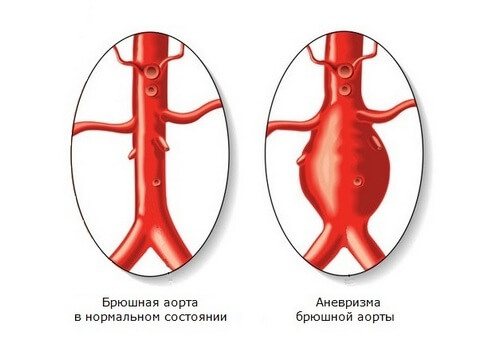
What is an abdominal aortic aneurysm?
Epidural hematoma - develops after traumatic brain injury. It manifests itself as symptoms of cerebral compression, dizziness occurs at an early stage, then depression of consciousness, peripheral paresis. Diagnostics – craniography, CT, MRI, echocardiography. Treatment is surgical only, treated by a neurosurgeon.
Diseases of the abdominal organs
The pain in these diseases radiates to the back, and dizziness occurs when homeostasis is disturbed (the constancy of the internal environment of the body).
Duodenal ulcer is a chronic disease in which defects form in the intestinal wall. It manifests itself as severe pain 3-4 hours after eating, sour belching, and the patient may feel nauseous to the point of vomiting. Characterized by “hungry” pain (passes after any meal), night attacks of pain. The course is undulating, exacerbations (seasonal spring-autumn) alternate with remissions. It happens more often in men, affecting up to 15% of the population. Diagnostics – duodenal intubation, gastroscopy, tissue biopsy, contrast radiography. Treated by a gastroenterologist. Treatment - diet, removal of Helicobacter (Metronidazole, Clarithromycin, Amoxicillin), reducing the acidity of gastric juice (Omez, Ranitidine), means to protect the mucous membrane (bismuth preparations).
Pancreatitis or pancreatic cancer is an inflammation or malignant tumor. Manifested by acute pain, nausea, lack of appetite. Clinical and laboratory diagnostics - biochemistry of blood and urine, ultrasound, CT, MRI. Treatment in a surgical hospital.
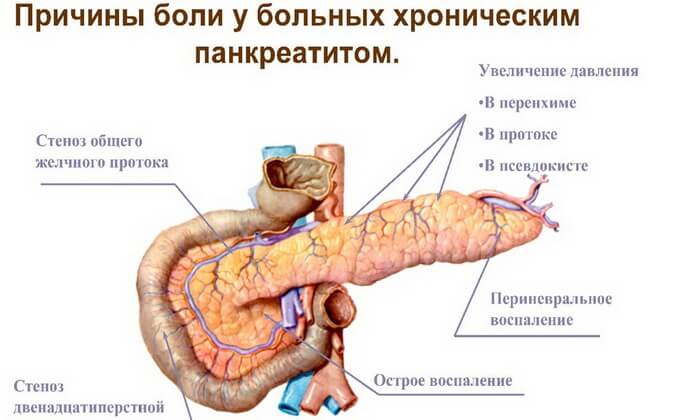
What is pancreatitis
Diseases of the genitourinary system
The source of pain is inflammation or stones.
Kidney diseases - inflammation of the cups or pelvis, pyelonephritis and glomerulonephritis. Manifested by increased body temperature, impaired urine output, weakness, and intoxication. Diagnostics - clinical, ultrasound, CT, MRI, laboratory tests, survey and excretory urography. Treated by a nephrologist. Treatment – antibiotics, anti-inflammatory, diuretics, restoratives, vitamins.
Urolithiasis is the formation of stones, manifested by renal colic. It manifests itself as acute pain, blood in the urine, and when the ureters are blocked - lack of urine. Diagnosis – clinical signs, ultrasound, x-ray, CT. Treatment - diet in accordance with the composition of the stones, lowering the level of uric acid (Allopurinol), vitamins of groups A, E, B, lithotripsy (crushing stones with ultrasound). If the stone is larger than the ureter or has the appearance of coral, surgical removal of part of the kidney or the entire organ is required.
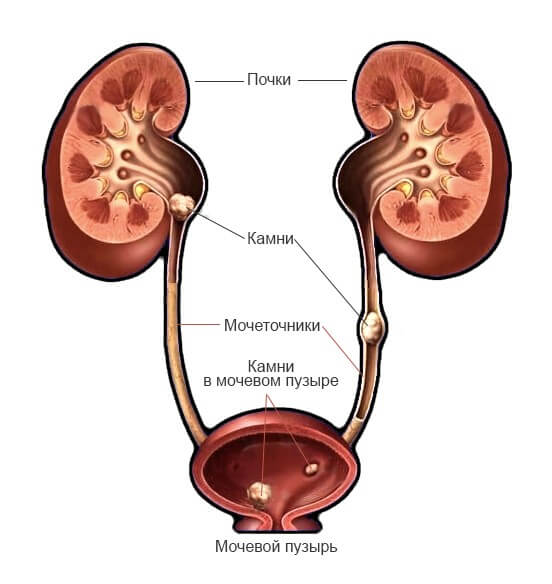
What is urolithiasis
Back pain can be caused by diseases of the spinal column itself. Here are the most common pathologies.
Spinal diseases
This is the most common cause of back pain.
Osteochondrosis
It is in first place in terms of frequency. With this disease, the vertebrae and intervertebral discs undergo degeneration (destruction). The intervertebral discs lose water, become less elastic and flatten, and the fibrous ring cracks. The distance between adjacent vertebrae decreases, the facet joints that connect the vertebrae to each other shift.
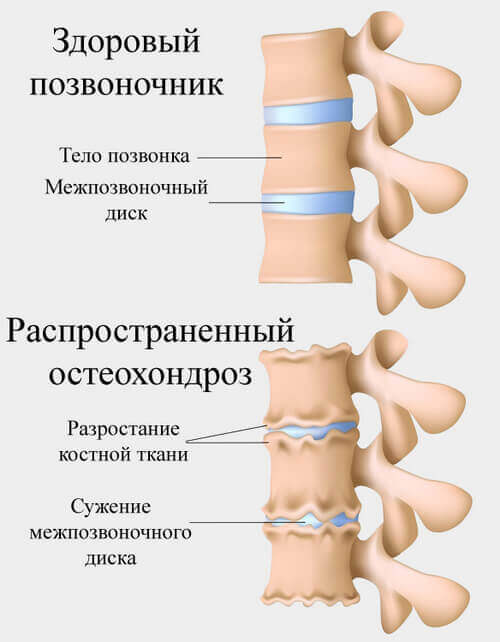
What does osteochondrosis look like?
All these processes change the spatial orientation of the spinal structures and interfere with the normal functioning of neighboring tissues. Gradually, the spine becomes unstable, bone growths (osteophytes) form on it, and the muscles, trying to hold the spine in the same position, are in constant spasm. Therefore, to the question: “Can you get dizzy from back pain?” — we answer, yes, maybe with severe pain.
With cervical osteochondrosis, ringing in the ears, deterioration of vision and memory may occur, pain can radiate to the shoulders, arms, and eyes.
The main manifestation of osteochondrosis is pain, which intensifies with movement. In an effort to avoid pain, the patient takes a forced position. The nerve roots coming out of the spinal column may be compressed, which only aggravates the situation.
Myofascial syndrome
This is a pain syndrome caused by the formation of compactions in the thickness of the muscles in the form of points (triggers). This syndrome is one of the most common causes of chronic pain. The diameter of one pain point reaches 3 mm, the group - 10 mm. Middle-aged women are more often affected. Trigger zones are formed due to osteochondrosis of the spine, prolonged uncomfortable posture, anomalies in skeletal development, bruises, stress on untrained muscles, and stress.
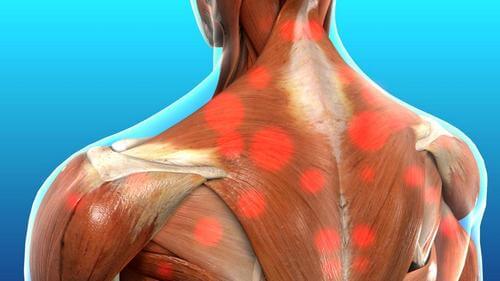
Myofascial syndrome manifests itself as acute pain when palpated
Myofascial syndrome is manifested by deep pain of moderate intensity, which initially intensifies with exercise, and over time becomes constant . When triggers form in the neck, tinnitus occurs.
Diagnosis is clinical, carefully palpating the area causing pain. When the trigger is pressed, the patient literally “jumps up” in pain. However, a thorough clinical examination is necessary to exclude other diseases. Treatment by a neurologist, therapist, orthopedist, traumatologist. Treatment - manual therapy, massage, reflexology, NSAIDs (Nimesil, Diclofenac), muscle relaxants (Tolperisone), therapeutic blockades, antidepressants (Fluoxetine).
Vertebral displacement
The vertebra can move forward, backward or sideways relative to the vertical axis. Along each vertebra there are peripheral nerves, arteries and veins. Posterior displacements are the most dangerous because they narrow the spinal canal. Sometimes with this pathology you feel dizzy after back pain.
Any displacement disrupts the normal functioning of nerves and blood vessels in its area. Manifestations depend on the level (cervical, thoracic or lumbar) and severity of the displacement. Variations range from slight numbness in the innervation zone to complete immobilization.
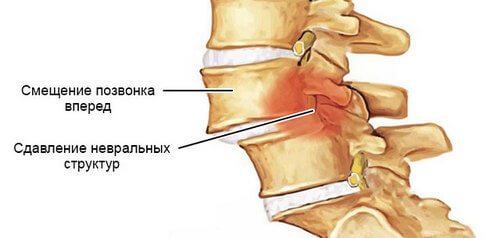
What is vertebral displacement
Diagnostics – X-ray, CT, MRI. Treatment is by a neurologist or traumatologist, and, if necessary, a neurosurgeon or vertebrologist.
Mild degrees are treated with NSAIDs, blockades, physical therapy, massage, acupuncture, and physiotherapy. Heavy - surgically installing metal structures that motionlessly connect adjacent vertebrae.
Shooting or lumbago
This is an attack of acute pain in the lower back, when a person freezes in one position. Pain occurs during physical activity, awkward movement, or jerking. The sensations are caused by a reflex muscle spasm in response to a tear in the fibrous ring. Middle-aged men are more often affected. The lower back is “constrained”, movements are sharply limited, the body position is forced.
Great article on the topic:
ALL about lumbago: what it is, symptoms, causes, treatment for lumbago at home

Lumbago is a sharp pain similar to an electric shock.
Diagnosis – clinical picture, x-ray, CT, myelography – x-ray after administration of contrast during lumbar puncture. Treated by a neurologist and vertebrologist. Treatment is complete rest in the acute period, NSAIDs (Diclofenac), therapeutic blockades. Then massage, UV irradiation, amplipulse, laser, acupuncture, magnetic therapy. The main thing in treatment is to neutralize the cause that caused the lumbago.
Ankylosing spondylitis
This is a chronic inflammation of the vertebral joints, which leads to immobility of the spine. Initially, pain and stiffness appear in the lower back, and then spread to the entire column. At the final stage, thoracic kyphosis (hump) is formed. Mostly men aged 15 to 30 years are affected. The disease is classified as autoimmune.
Diagnostics – clinical (history and examination), X-ray, CT, MRI, examination of internal organs. An immutable sign is fusion of the thoracic vertebrae. Treatment - glucocorticoid hormones (Hydrocortisone, Dexamethasone), NSAIDs (Ibuprofen), immunosuppressants (Azathioprine, Methotrexate), exercise therapy, magnetic therapy, acupuncture, radon baths.
Other diseases
Among other diseases, facet syndrome occupies a special place. This is the main manifestation of deforming spondyloarthrosis. The pathological process involves the facet joint (facet, posterior segment connection), intervertebral joint capsule, ligamentum flavum and other tissues surrounding the spine. It manifests itself as severe pain, which intensifies when walking and standing for a long time, radiating to the legs.

With facet syndrome, additional pain may radiate to the legs
The sensations are so intense that the patient’s ability to work is impaired. Diagnosis - MRI, since the rest of the clinical picture is similar to other diseases. The best treatment is facet infiltration, where a local anesthetic (Lidocaine) combined with a corticosteroid hormone (Cortisone) is injected into the joint.
Muscle weakness in the legs: why are the causes often nervous?
It is well known that the causes of weakness in the legs can be nervous. After all, everyone in their life has at least once been so nervous that their legs buckled from fear. But as soon as the stressful situation disappeared, the trembling in the knees also went away.
But with neurotic anxiety disorder it does not disappear. And if it disappears, it returns again. Let's figure out what are the reasons why this happens and what to do about it.
Symptoms
Characteristic signs of this condition are:
- a feeling that the legs are cottony, or rubber, or even made of jelly;
- fear of loss of balance and a feeling of unsteadiness in gait (weakness in the legs often manifests itself simultaneously with psychogenic dizziness);
- a feeling that your legs are about to bend at the knees, and an inevitable fall will occur, after which you will not be able to get up;
- paresthesia, numbness in the lower extremities;
- trembling in the legs, sometimes imaginary, sometimes actually noticeable.
All of the above symptoms may appear simultaneously, or they may occur one after another. Sometimes just one manifestation can be annoying.
The intensity of symptoms can vary from extremely strong to subtle. The condition can change hour by hour, day by day, etc. Sometimes the problem can disappear for several days, months, or even years, and then return again.
Symptoms of leg weakness are often accompanied by poor general health, drowsiness, dizziness, and muscle pain throughout the body. In most cases, there are other bodily manifestations of chronic anxiety, often called VSD (vegetative-vascular dystonia): rapid pulse, sweating, chest pain, nausea, etc.
Difference from somatic diseases
Like any other ailment, such manifestations of bodily discomfort as weakness and numbness in the legs, including dizziness, can have serious somatic causes. May indicate the presence of a serious illness.
Exaggerated Expectations
People who suffer from neurological ailments accompanied by dizziness and myasthenia gravis (muscle weakness in the legs and arms) are actually weak.
That is, they don’t feel like they’re falling. They fall in reality. They don’t feel like their knees are about to give way. They are actually collapsing. And the man falls. Such patients really cannot get to their feet. And they actually have an unsteady gait, which is noticeable to everyone around them.
Similar psychogenic symptoms manifest themselves in a completely different way. Not a single neurotic has ever fallen anywhere. No one but him sees his unsteady gait. The lower limbs are always threatening to stop supporting the body, but they have never done this before.
Such a dialogue often occurs between a doctor and a neurotic patient.
— When was the last time you fell?
- Yesterday I almost fell.
- A little bit or fell?
- Well, I managed to sit down.
- So you didn’t fall?
- Oh no…
Neurotic patients always have time to sit down and grab something. This is how they get fabulously lucky all the time. Unlike truly sick people, who actually fall and often do not even suffer from the moment when they began to fall. Everything happens suddenly.
Temporality
If the causes of numbness and powerlessness in the legs are of a serious neurological nature, they will not go away. A person cannot stand on his feet all the time. At the same time, without treatment, the symptoms only intensify, but do not go away.
Neurotic weakness of the lower extremities manifests itself in a completely different way. Either she is there or she is not. For example, in the morning it can be very strong. To weaken by lunchtime. And in the evening, be completely absent.
She may not be at home. But she will appear on the street.
It may be absent when there is a reliable accompanying person nearby, for example, one of the parents. But it shows itself clearly when moving independently.
Any options are possible.
But symptoms never increase in a straight line. They appear and disappear. They sometimes get stronger, sometimes they get weaker.
General neuroticism
Sweetness in the legs is almost never the only bodily symptom of chronic anxiety. In most cases, other autonomic manifestations also occur, be it tachycardia, abdominal pain or a nervous cough.
It is usually noticeable to the naked eye that a person who is constantly afraid that his legs will give way out of the blue is not in the best, not the calmest mental state.
Adrenaline rush
The main cause of nervous weakness in the legs is the release of adrenaline in response to anxiety. Under the influence of adrenaline, the muscles of the lower extremities become so tense that they feel like they are trembling. Sometimes they can actually tremble, just as hands can shake due to nervousness.
Absolutely everyone is familiar with this reaction of the body to excitement and fear. Every person has ever had their legs give way from fear or anxiety, for example, during an exam. However, as soon as the fear went away, the sweetness in the knees also disappeared.
For people who suffer from anxiety disorders, things are a little different. They worry constantly, even if they don't notice it. Or they attribute their anxiety to bodily symptoms. They say that this sweetness did not arise because I am anxious. And I worry about weakness. It's just the opposite.
Intrusive thoughts
Every person may from time to time experience weakness in the limbs, their bouncing, thoughts that I’m so tired that I won’t make it home, I’ll fall somewhere. All these phenomena exist in the life of every person. Even very young and completely healthy.
But only in a neurotic patient do all these normal appearances of fatigue evoke thoughts about the presence of a serious illness. And once such a thought arises, it often becomes obsessive. And the person can only think about the fact that he is dizzy, that his legs are weak, and that he is going to fall.
Of course, such thoughts are scary and only increase discomfort in the body. And they, in turn, convince the neurotic that he is afraid for good reason - the terrible disease has already arrived.
It turns out to be a vicious circle: anxiety - weakness of the legs - thoughts that this is something scary - fear - increased weakness of the legs - thoughts that this is definitely something terrible - fear - weakness... And so on ad infinitum.
How to get rid of it?
The process of such treatment is long and complex. And it often costs a lot of money if you do not work independently, but turn to a psychotherapist for help.
Therefore, it is important to know how to reduce the manifestation of symptoms here and now, and relieve muscle fatigue.
There are several ways to reduce psychogenic tremors in the legs, their weakness and the feeling of weakness and helplessness.
Source: https://nevrozanet.ru/trevoga-i-fobii/simptomyi/fizicheskie/slabos-v-nogah/
Table: additional symptoms and causes
| Add. symptom | Cause |
| Back hurts, dizzy | Osteochondrosis, ankylosing spondylitis, vertebral displacement, myofascial syndrome, pregnancy, premenstrual syndrome, prostatitis, renal colic, myeloma |
| Neck hurts | Cervical osteochondrosis, cervical spondylosis, trauma, disc protrusion (hernia), meningitis (inflammation of the meninges), myositis (inflammation of the muscles), neuralgia |
| Lower abdomen hurts | Enteritis, menstruation, pregnancy, prostatitis, radiculitis |
| I have a stomachache | Appendicitis, gastritis, gastric ulcer, pancreatitis, cholecystitis |
| Dizziness | Meniere's disease, stroke, fasting, hypertensive crisis |
| Headache (pain in the head) | Fatigue, lack of sleep, stress, stroke, hypertension |
| My stomach hurts | Gastritis, poisoning, food intolerance, ulcer, erosion |
| Chest hurts | Cardiac ischemia, thoracic radiculitis, bruise, neuralgia |
| Weakness | Diabetes mellitus, anemia, tuberculosis, HIV, influenza, fatigue |
| Back muscles hurt | Physical activity, bruise, spondyloarthrosis, disc herniation |
| Be sick | Infection, poisoning, pregnancy, intestinal diseases |
Only my left leg hurts
Head pain, aching, burning in the joints can be the causes of many pathologies: injuries, bruises, vascular damage and even other skin or internal diseases.
Similar symptoms are observed with thrombophlebitis, varicose veins, atherosclerosis, vegetative-vascular dystonia, atrophy of the venous walls, and also with stagnation of blood outflow, leading to weakening and stretching of the veins.
Not only the arms, but also the legs ache due to venous thrombosis, the joint hurts and swells.
The reasons may be physical: constantly wearing tight, uncomfortable shoes with high heels.
Skin diseases of the feet and fungal infections are possible. The lower joints and arms and lower joints burn due to improper metabolism, blood and kidney diseases.
The joint below the knees aches and hurts due to problems with the endocrine or nervous system, diabetes, gout, and vitamin deficiency in the body. Often my arms ache and my legs hurt a lot. This problem is familiar to overweight people, so excess weight needs to be fought.
When there is poor circulation, low blood pressure, or vegetative-vascular dystonia, the legs are often cold.
If there is a deviation in the structure of the blood vessels, patients begin to complain that they have a headache, and with narrowing of the blood vessels and lack of blood circulation, the lower extremities are cold and this is no longer a trifle.
If you ignore the situation, you can start the disease, then the symptoms can become more pronounced and permanent.
In fact, the causes of such pathologies may be different. It’s not so scary if your feet are cold - with hyperhidrosis and it’s enough to normalize your water and food balance.
Until now, such problems were attributed to a cosmetic defect, but this clearly slows down the blood flow.
In addition, cold lower extremities and aching arms occur with cardiovascular, infectious diseases, menopause, oncology, and problems with the thyroid gland.
When do your hands go numb?
If your legs burn badly, then these are signs of neuralgia, osteochondrosis, pinched nerve roots. With a total lack of sensitivity in certain parts of the body, dizziness, numbness of part of the face and tongue, patients experience a pre-stroke state.
Paresthesia or numbness of the limbs is possible under some conditions, for example, when staying in an uncomfortable position for a long time or during sleep. The same symptoms occur in diseases of the nervous or vascular system.
Hands burn due to inflammation, pinched nerve endings. If other parts of the face are affected by paresthesia: tongue, lips and head, then a more serious illness can be assumed - facial paralysis.
Headache, also in the area of the eyes and nose with trigeminal neuralgia.
With viral pathologies, herpes, stress, ischemic attacks, there is strong shooting, throbbing pain in the head, aching joints, and increased temperature. In addition to the soreness of the head, the limbs go numb or ache, they burn intensely with:
- poisoning by poisons, mushrooms, snake or insect bites;
- burns, thermal damage to the skin;
- migraine;
- long-term use of medications (in particular antibiotics), hormonal agents;
- cervical osteochondrosis;
- pinched nerve;
- incorrect use of inhalers;
- development of a tumor in the brain;
- dental procedures, for example, from the effects of anesthesia. It happens that at first the lower limbs burn strongly, then go numb and spasm in pregnant women or people leading an overly active lifestyle.
Cold feet syndrome often occurs in children with rickets and vitamin deficiency. However, such phenomena are not so harmless, but against the background of hypothermia, you can get inflammation of the appendages or genitourinary system. Many parents do not pay much attention to when their feet are wet, for example, after street walks. Pediatricians do not consider such troubles to be the norm.
These are already serious illnesses, symptoms of improper functioning of some internal organs, circulatory disorders, poor blood circulation in the extremities. Constantly cold feet are a syndrome and not a good sign.
It is possible to develop rickets at the initial stage, requiring a visit to a doctor, diagnostic testing, a therapeutic course of medication, vitamin therapy, and the appointment of an individual diet.
How to get rid of it?
First of all, you need to adjust your diet. Spicy foods and salt inevitably lead to gradual deposition in the joints and an increase in cholesterol levels in the blood.
Bad habits and smoking lead to the destruction of collagen, without which the normal functioning of vascular structures is impossible. It is equally important to pay attention to shoes, stockings, and socks. They should not interfere with normal blood flow in the legs, restrict or compress the joints.
Relaxing contrast baths with the addition of medicinal herbs and massage are useful. In hot weather, wash your feet with cool water to relieve spasms and swelling. Loads must be dosed.
The joints are subject to constant increased stress. Aches in the limbs of the legs often occur when sitting for a long time, tucking under oneself. The limbs need warmth, so it is recommended to use warming balms, take warm baths, and rub with essential oils, preferably before bed, so that you can put on warm socks and try to sleep.
How to fight?
Depending on the factors that provoked numbness and pain in the joints, a course of treatment with corticosteroids gives positive results.
Usually the fingers and toes become very numb, and the head hurts due to neuralgia, so painkillers and anti-inflammatory drugs are used to relieve spasms.
It is useful to rub joints with alcohol, massage (in particular the head), acupuncture and acupuncture, and gymnastics for the muscles of the neck and face.
The tone is greatly increased with osteochondrosis, so the head hurts and the limbs buzz. Physical exercise is necessary if your legs, arms are cold and your back muscles are in good shape.
If your feet are constantly freezing at home, you can use lotions, poultices with the addition of ginger, ground pepper or dry mustard to hot water. To relieve fatigue, a daily foot massage is recommended. In no case should movement be hampered by uncomfortable tight shoes or tight tights, or tight elastic bands on socks that reduce blood flow to the toes.
Exercises are indispensable when the soles of the feet are burning, flexion (extension) of the fingers, rotation of the feet. And so, eventually, the burning stops, the numbness goes away, and blood circulation improves. It is good to rub and knead each finger individually, for example, walk on pebbles, peas, buckwheat, stones right at home, simply pouring them into a basin.
Need to remember
Often your feet burn badly and you even get a headache from constant exposure to aggressive material in your shoes - insoles or synthetic soles. Many people don't even notice it. But do not forget that the skin also breathes. Many allergens cause itching, irritation and burning of the skin. In this case, anti-allergenic agents and ointments are applicable.
Of course, if the advice does not help, then it is better not to engage in self-medication, turn to specialists as quickly as possible, undergo the proposed examination procedures, identify the root causes of troubles and eliminate them at an early stage of their occurrence. Otherwise, the development of many pathologies (in particular varicose veins) in the body and joints can lead to serious complications, including cuts and immobility, and ultimately to disability and the inability to walk independently.
Main culprits
First aid
See a doctor - he will help you make the correct diagnosis. You can take medications or take a certain anti-pain position only if the cause of the pain is established during the examination.
If the cause of the pain is known and it is associated with the spine, then to reduce pain it is necessary:
- Provide rest to the patient. For lower back pain, lie down on a hard surface, place your legs on a chair, bend your knees at an angle of 90º.

Posture for back pain - Take 1-2 painkiller tablets: Nise, Diclofenac, Ketorolac.
- In the absence of inflammation, alternately apply hot and cold compresses for 15 minutes for 2 hours.
- If symptoms do not go away after 1-2 days, consult a doctor immediately.
Prevention
For some reason, traditional medicine is not very popular. Although there are still a large number of preventive measures that will help prevent headaches and various ailments. Every day you need to drink a normal amount of water and limit yourself to drinking coffee and other drinks.
Follow a daily routine, eat right, exercise and lead an active lifestyle. Try to avoid stress. For headaches that are not chronic, it is useful to use knowledge from traditional treatment, which has been proven by many generations, as ways to effectively combat diseases.
Drug treatment
We list the main painkillers for back pain that are included in the course of proper conservative treatment.
Non-narcotic analgesics
These painkillers relieve pain symptoms due to any reason. With a short course of therapy there are practically no side effects.
- Baralgin M – from 305 rub.
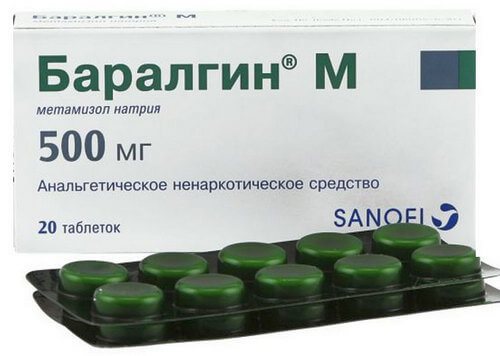
Baralgin M is an effective analgesic for back pain - Analgin – from 22 rub.
- Solpadein Fast – from 165 rub.
Nonsteroidal anti-inflammatory drugs (NSAIDs)
Such drugs are prescribed most often. They suppress the inflammatory process and reduce pain. They can cause a number of side effects, such as stomach pain.
- Diclofenac (Voltaren, Diclovit, Ortofen, Diclak). Inexpensive and effective drug. Price from 20 rub.
- Nise (Nimesil, Nimesulide). A good drug, causes few side effects. Costs from 220 rub.
- Arcoxia – from 405 rub.
- Meloxicam (Artrosan, Movalis) – from 80 rub.
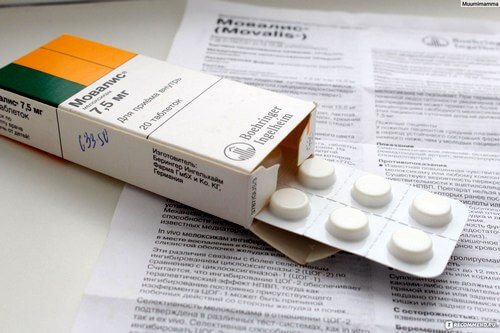
Movalis is a safe NSAID that is well tolerated by many patients - Ketorolac (Ketanov, Ketorol) – from 50 rub.
- Lornoxicam – from 205 rub.
- Ketonal (Flamax, Bystrumcaps) – from 105 rub.
- Celebrex (Celecoxib) – from 210 rub.
Muscle relaxants
This type of medication aims to relax the back muscles. They are combined with other treatments to increase effectiveness. For example, with NSAIDs. Only a doctor should prescribe muscle relaxants.
- Tizalud – from 185 rub.
- Tizanidine – from 155 rub.
- Baklosan – from 320 rub.
- Mydocalm - from 410 rub.
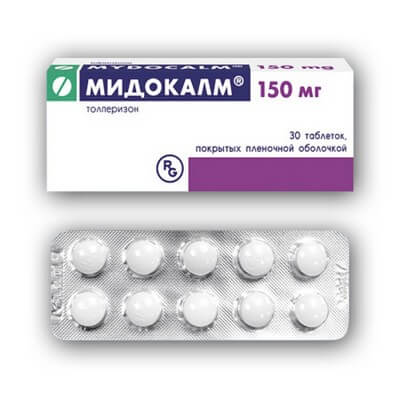
Mydocalm combines well with NSAIDs - Sirdalud – from 260 rub.
Narcotic analgesics
If NSAIDs do not help, and the pain is very severe, then narcotic painkillers may be prescribed. They block pain signals from reaching the brain. They are sold by prescription only.
- Tramadol;
- Vicodin;
- Morphine;
- Fentanyl.
Hormonal glucocorticosteroids
These medications contain the hormone cortisol. Hormonal drugs are prescribed if NSAIDs and muscle relaxants do not help. They are allowed to be used no more than once a year - the side effects can be very serious.
- Cortisone – from 910 rub.
- Methylprednisolone – from 210 rub.
- Kenalog – from 360 rub.
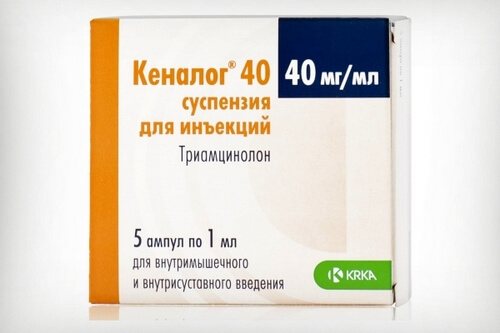
Kenalog helps when NSAIDs are ineffective - Dexamethasone – from 60 rub.
- Diprospan - from 230 rub.
Be sure to read this good article:
TOP 100 drugs for pain in the back, lower back and joints: painkillers, injections, suppositories, ointments, patches
B vitamins
It has been proven that these medications relieve pain, normalize the nervous system, and improve the condition of nerve endings.
- Milgamma – from 320 rub.
- Trigamma – from 190 rub.
- Combilipen - from 180 rub.
Chondroprotectors
When chondroprotectors are used for 3 months or more, damaged cartilage tissue in the intervertebral discs and joints is restored.
- Artradol - from 850 rubles;
- Don - from 1350 rub.;
- Mukosat - from 660 rubles;
- Alflutop – from 1700 rub.
Novocaine blockades
These are injections into painful (trigger) points, or between the vertebrae (epidural block). They are placed only in cases of very severe pain that cannot be relieved with NSAIDs and analgesics.
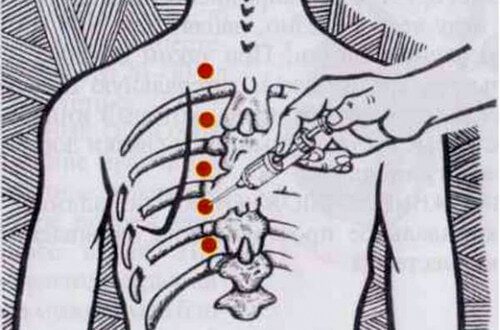
Novocaine blockades are placed urgently, in case of very severe pain.
The blockades take effect very quickly. The composition includes Novocaine and a corticosteroid (Diprospan, Prednisolone). The procedure must be performed by an experienced doctor.
Candles
This type of treatment is prescribed to those patients for whom tablets and injections are contraindicated. Rectal suppositories are inserted directly into the anus before bed. The course of therapy is 5 days.
- Voltaren - from 310 rubles;
- Ketonal - from 270 rubles;
- Diclovit - from 175 rubles;
- OKI - from 295 rubles;
- Diclofenac – from 55 rub.
Great article on the topic:
TOP 50+ best pain-relieving suppositories for pain in the back, lower back and joints
Ointments
Simultaneously with the use of tablets and injections, you can use local remedies: ointments, gels and creams.
The ointment can be used up to 3 times a day for 1-2 weeks.
Pain relieving ointments:
- Nise – from 280 rub.;
- Ketoprofen – from 105 rubles;
- Fastum gel – from 285 RUR;
- Dolgit – from 110 rubles;
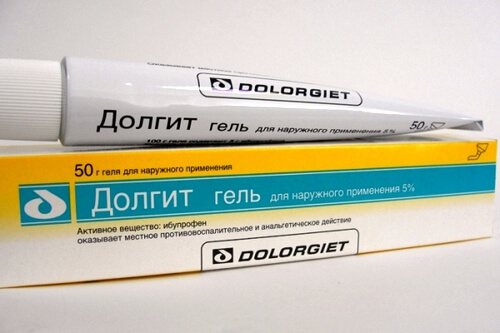
Dolgit provides analgesic and anti-inflammatory effects - Voltaren emulgel – from 235 rubles;
- Dolobene – from 480 rubles;
- Viprosal B – from 385 rub.
Plasters
This is a very convenient form of local remedies. The product is a plate with a medicinal substance applied on one side. The patch should be applied to the painful area and kept for the specified period.
The most effective pain patches:
- Voltaren – contains diclofenac sodium, is effective for at least 24 hours. Price – from 275 rub.
- Versatis contains lidocaine and lasts up to 12 hours. Costs from 910 rub.
Mydocalm tablets and injections - instructions for use
Mydocalm tablets and injection solutions of the drug are used to treat muscle hypertonicity, joint damage, in postoperative rehabilitation therapy and other medications.
The drug is a muscle relaxant and has a central effect.
The bioavailability of the drug is within 20%, the maximum concentration of mydocalm is observed 30-60 minutes after use. The active substance of the drug is well absorbed in the stomach and intestines.
Metabolism of tolperisone occurs in the liver and kidneys, metabolic products are excreted in the urine (more than 99%). The exact activity of the metabolites has not been established.
Instructions for use indicate that Mydocalm should be used in the following cases:
- Hypertonicity of striated muscles due to various neurological pathologies of the central nervous system: myelopathy, encephalomyelitis, multiple sclerosis, cerebral stroke, cerebrovascular accidents outside the acute phase, lesions of the pyramidal tracts.
- Muscle spasms and contactures accompanying joint diseases (spondylosis, arthrosis of large joints, spondyloarthrosis, lumbar syndrome, cervical syndrome).
- Rehabilitation therapy after surgical intervention in the orthopedic and traumatological spheres.
- Encephalopathy accompanied by muscular dystonia, including Little's disease (infantile cerebral paralysis).
- As an adjuvant for disorders of blood flow and lymphodynamics after thrombus formation (diabetic angiopathy, thromboangiitis obliterans and arteriosclerosis, scleroderma, Raynaud's disease).
- As part of complex therapy for vascular innervation (intermittent angioedema, acrocyanosis).
There are also contraindications:
- allergic reactions to lidocaine (when used by injection);
- hypersensitivity and individual intolerance to the active substance of the drug (tolperisone hydrochloride) or any component;
- myasthenia gravis;
- children's age from birth to 3 years when used in tablet form;
- children's age from birth to 1 year when used in the form of injections.
Mechanism of action
The mechanism of action has not been fully studied, but it is assumed that it is associated with the correction of the function of the caudal part of the reticular formation and reduces the reflex excitability of the spinal cord when it increases.
It influences nerve endings in the periphery and the activity of spinal synapses.
Other treatments
Traditionally, traction is used to treat the spine, most effectively in water. The patient is placed on a traction (stretching) table, one weight is suspended on a tape to the chin, the other to the legs. The forces are directed in opposite directions for better tension. The strength and time of the procedure is calculated by a doctor or computer based on examination data.
Manual therapy also shows good effectiveness. Even after one session, noticeable improvement is possible. The main thing is that the chiropractor is an experienced specialist and has the appropriate medical education.
Massage can also have a beneficial effect on the body. Therapeutic, acupressure and cupping massages are used.
